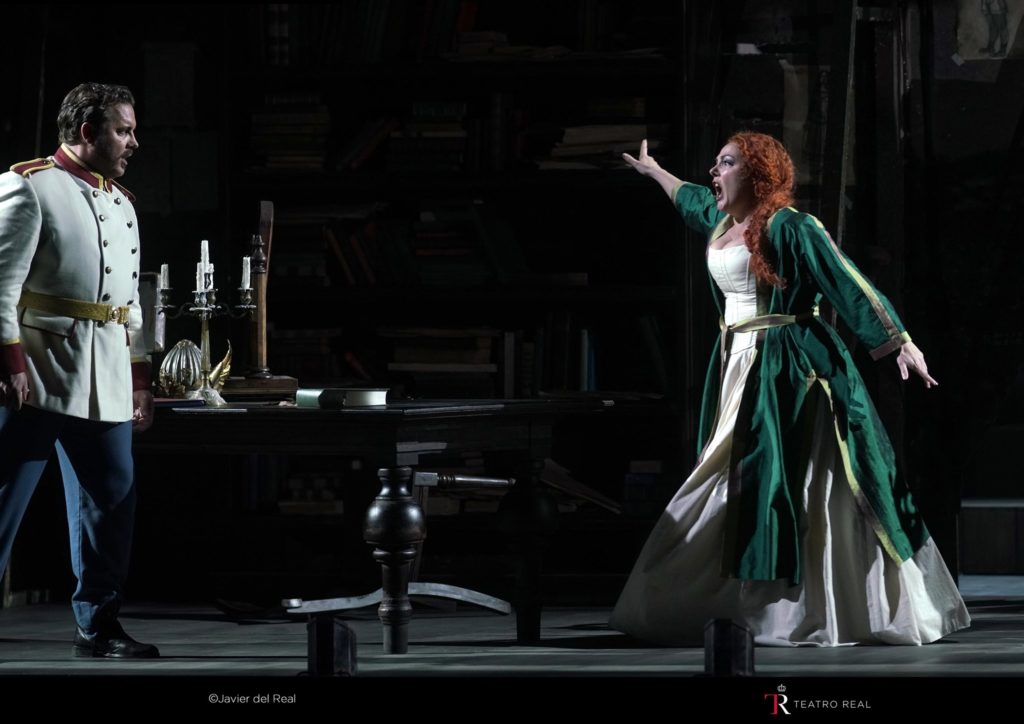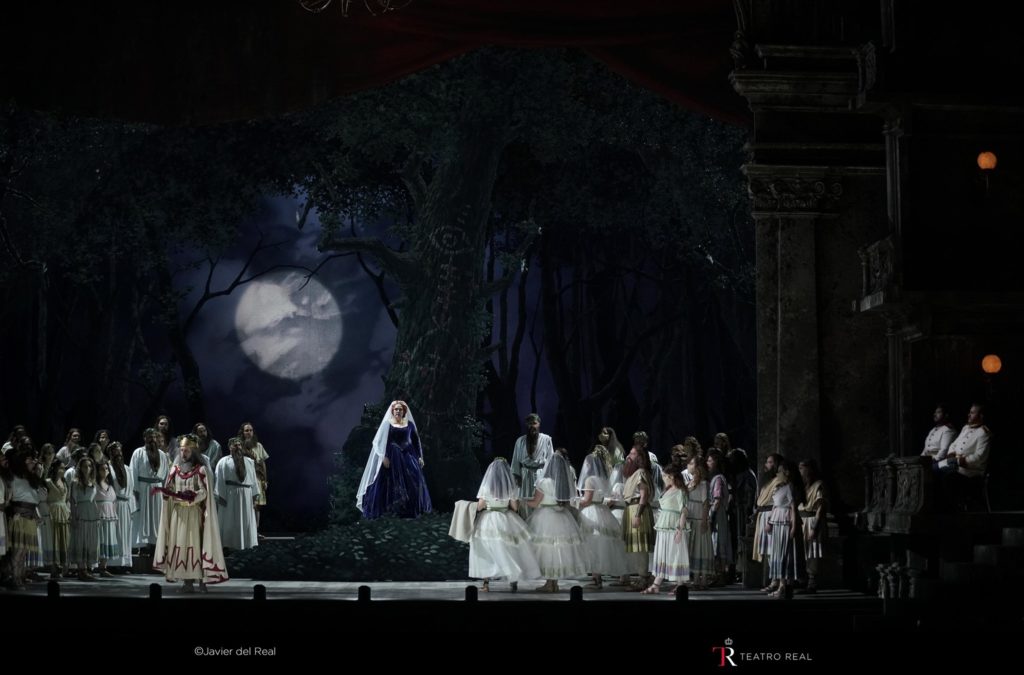
Teatro Real de Madrid 2020-2021 Review: Norma
Yolanda Auyanet Shines in Justin Way’s ‘Norma’ Production
By Mauricio Villa“Norma” has probably been the only Bellini work that has always been present in the operatic repertoire since it premiered at the Teatro alla Scala in 1831. After its failure on opening night it turned out to be a real success following its second performance and quickly went on to be performed throughout Europe and North America. It became the signature role of every prima donna because, according to the vocal writing which Bellini accommodated for Giuditta Pasta, the first Norma, the role has been sung from dramatic coloratura to leggero sopranos. They have taken it as a challenge to overcome all the difficulties that this role presents both vocally and dramatically, considering that “Norma” has “Casta Diva:” one of the most famous arias of the operatic repertoire and one that is extremely difficult to sing. Bellini had originally written the aria in another key, one tone higher, but due to Pasta’s struggles to sing it, the composer lowered the aria to what is known today. Many leggero sopranos, like Joan Sutherland, Beverly Sills, and Edita Gruberova, have sung this aria in its originally-intended higher tone.
The Teatro Real, in its 2021 staging of “Norma,” only added to this already-impressive catalogue of accomplished performances with a shining cast and staging which nostalgically hearkened back to opera’s origins and could be considered a ‘return to form’ for Bel Canto.
A Splendid Norma
The Spanish soprano Yolanda Auyanet, who had incredible success singing Bellini’s “Il Pirata” at the Teatro Real in 2019, was astonishing as Norma. Auyanet has all the vocal and dramatic qualities required for this role: a wide tessitura, a secure lower and upper register, stamina, and good breath support. She can also phrase long Bellini melodies and has the ability to color the voice with different shades. She also sings with a great variety of dynamics and her acting is dramatic. In all, she expresses the different deep emotions that this role requires.
Since she began her career singing leggero roles in “Rigoletto,” “Lucia de Lammermoor,” and “Don Pasquale,” she has a splendid control of the coloratura. Her voice has evolved with time to become a pure lyrical soprano, as her center has widened and her voice has grown in volume. She began her entrance recitative—Sediziose voci de guerra”—with strength and determination, using the dark color of her voice to give dignity and power to the character. Right after the recitative, Norma sings the famous and difficult aria “Casta Diva.” Auyanet embraced the slow tempi with her secure breath technique, singing in mezza voce as this scene, which revolves around a lunar ritual, thematically requires. Yet she could still widen her voice for the climactic lines “Il bel sembiante… quella pace,” where she had to sustain five consecutive A naturals to ascend softly into a high B flat. Her roulades, right through to her final cadenza, were cleanly sung with style. She changed her mood during her cabaletta, which is only one of the very few moments when Norma expresses joy as she remembers and wishes her Roman lover to return to her arms. She sang joyfully with a pure coloratura and the three high Cs, which the piece requires. Auyanet added some minor variations as the cabaletta was sung without a repeat.
The beginning of the last scene of Act One presents, for the first time, Norma’s doubts and dichotomy over her love for her children. Norma’s role is a rollercoaster of emotions, and it is in this scene where the drama really begins. Auyanet telegraphs her doubts and remorse while conferring with her maid, switching back into her heroic priestess persona for the beginning of her duet with Adalgisa, to change once again as she celebrated her love and her friendship with Adalgisa with floating long lines, secure coloratura, and strong attack on the several high Cs. The beginning of Act Two was terrifying and emotional as Auyanet portrayed Norma as a truly tragic figure in a poignant scene where she contemplates murdering her own children. Auyanet showed her strong low chest register in the line ‘Schiavi d’una matrigna.’ The highlights of her performance were the lines; ‘Oh, non tremare, o perfido,’ which was full of fury as her coloratura expressed perfectly Norma’s anger followed by two thunderous high Cs; the line ‘Son io,’ which was sustained in a perfect diminuendo when Norma admits her sins and guilt; and the long final ensemble scene where Auyanet expressed the pathos and dignity of her character as Norma finally recognizes the hypocrisy and lies she has embraced and ultimately achieves redemption through sacrifice, walking with her betrayed lover to the funerary pyre. Auyanet gave her soul and all her vocal abilities to recreate this mythical character with honors, obtaining the recognition of the audience in her final bow.

Uneven Support
As soon as Clémentine Margaine began singing her first lines ‘Sgombra è la sacra selva,’ I thought the role of Adalgisa would not suit her voice well. While her performance proved that I was not wrong, it was clear that Margaine is not a natural coloratura mezzo and that this role is not the most natural for her. She has a very powerful dark big voice, with potent and resonant low notes, like the first low B flat at the end of her first line ‘compiuto il rito,’ which she sang with amazing volume. But her first A natural, though sonorous and big, sounded heavy and uncomfortable. Adalgisa’s first duet with Pollione is written in a central tessitura with several ascensions to high G and A flat, and a high B flat at the end, and Margaine had no problem singing over the orchestra. However, the quality of her voice could sound much better in the Verismo repertoire. Adalgisa has no solo aria, she sings three duets and one trio, and was written for Giulia Grisi, for whom Bellini wrote the role specifically. Even though Grisi began her career singing contralto Rossini roles, she later premiered Bellini’s “I puritani” which meant that her voice, even having a good low register, was agile, light and could reach at least a high D flat—which is the highest note written in “I puritani”—and can sustain high Cs easily. In contrast, Margaine’s problems began with her first duet with Norma—”Oh, remembranza”—where she has to sing on the same tessitura and melodic lines as Norma and sound like a pure, virginal priestess. Not only did her voice not match the expectations of the role but besides skipping the written high C, her coloratura lacked clarity. It was in Adalgisa’s legato writing that Margaine had no issues such as the Act one trio with Norma and Pollione. Here her voice was perfectly present over her colleagues and the orchestra.
Her second duet with Norma—”Odi Sanar quest’aura… mira o Norma”—was sadly transposed a whole tone lower, which was usually done in the past when mezzo-sopranos sang the role, but that does not seem appropriate today as there is much more musical rigor. Instead of the several high Cs and B flats that Adalgisa has to sing, they became high B flats and A flats. This meant the duet was comfortable for Margaine and that the duet had less coloratura. Margaine’s middle and lower register is beautiful and her high notes are extremely potent. She also phrases beautifully and easily maintains the long legato melodies of Bellini. However, the fact that Auyanet’s dark velvet voice did not create a pleasing contrast with Margaine’s obscure, voluminous voice is a casting issue. It is clear from the way the role is written—and it has usually been interpreted like this in recent years—that Bellini wanted a light, white quality of sound for the young and virginal Adalgisa.
The American tenor Michael Spyres portrayed the Roman consul Pollione. He has a strange and astounding type of voice which has been named ‘bari-tenor,’ and such a voice was quite popular in Rossini’s operas. This means that despite having a baritone’s color and a strong middle and lower register, he can reach extreme high notes like a high F. Spyres’ first entrance recitative—”Svanir le voci”—was mesmerizing for his dark obscure timbre: he really does sound like a baritone. But his voice changed on the high G as it did not carry and this high register took on a white, pure quality, lacking projection and making his timbre completely uneven. It seemed as if two different tenors were singing. He had no problem projecting in his cavatina “Meco all’altar di Venere” as the orchestration was very light and easily sustained a high C in the vowel ‘I’ as demanded by the score. This note is not usually sung when spinto and dramatic tenors sing the part. Spyres has a beautiful vocal line and his use of dynamics and phrasing make him a perfect Bel Canto romantic tenor. He was consequently perfect for what Bellini had intended for this role. We have to take into consideration that in Bellini’s time the orchestras and the venues were smaller, which required less volume and projection. The issue with Spyres only arose when the orchestra forte. The final high B flat of his cabaletta “Me protegge e me difende” was utterly inaudible and he was drowned out during the second part of the trio that closed Act One by the voices of Auyanet and Margaine.
The highlight of Spyres’ performance was, without a doubt, his Act Two duet with Norma “Si, Io vil non sono,” where he delighted in the lower dramatic writing, giving a theatrical and tense interpretation while being vulnerable and remorseful in the final ensemble that closes out the opera. He is a great Bel Canto tenor who establishes how the role should be sung, veering away from the misinterpretations of the past which has been to assign heavy voices to this role.
Bass Roberto Tagliavini showed his expertise in the Bel Canto repertoire with his deep, dark metallic sound and great use of legato as Oroveso. It is a short but crucial role that only has two arias always accompanied by the male section of the chorus and recitative.
The Teatro Real chorus kept its high standards, especially the male section which is more present in this work. And the audience appreciated the chorus’s effort of singing the whole opera with masks but without ever being muted.

An Effective Production
Justin Way’s new production brought nothing new. His concept of showing a theater within the theater has been done numerous times. In this production, he set the action during the period when the opera first premiered, mixed stage costumes with clothes from the 19th century, and drew parallels between the oppression of the Gauls and the oppression of Italians by showing an Italian flag with a slogan expressing Italian liberty. It was not new and didn’t feel refreshing. The presence of theater boxes on one side of the stage was reminiscent of Robert Carsen’s productions of “Tosca” or “Les Contes d’Hofmann” and even the recent “Nabucco” at the Palau of Les arts.
But even if the production lacked originality, it did transmit the essence of the opera. Way did a good job, and just for once, at a time when the conceptual, the original, and the modern reigns supreme in staging and set design, it was nice to see a forest, rocks, and druid costumes. The final scene was Way’s most original touch as the canvas sets fell abruptly to show the opera house in flames. The choir and Oroveso rushed out of the stage while Norma and Pollione walked into the burning building. It was a splendid effect for a climactic dramatic ending.
Italian conductor Marco Armiliato extracted every single detail of the score to give a passionate and moving performance, something which is not easy considering the oft-criticized simple orchestration of the Bel Canto repertoire. Armiliato extracted the emotions which Bellini wrote for the orchestra instead of providing a mere accompaniment for the voice. The overture was strong, heroic, and bombastic. You got the feeling that he was breathing with the singers, unifying their voices and the music. It is unfortunate that he offered a cut score, performing the cabalettas without repeats, and cutting the codas from the duets and ensembles. According to the theater this was done to accommodate the government-imposed curfew brought on by the Covid-19 situation.
In all this performance was a great effort to return to the real essence of Bel Canto demonstrating a strong delicate musical reading.


